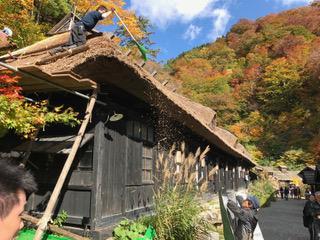Shortly after I hired Phil, the man-who-would-become-my-husband, the first sushi restaurant in New York opened across the street from our office. He became entranced by the slices of fish glistening like jewels and it’s been his favorite food ever since. To celebrate a Big Birthday, I planned the ultimate sushi tour of Japan.
After a 12-hour flight, we had an artistically arranged sashimi platters at the hotel, a wise choice since I was so overwhelmed by jet lag, I fell asleep with chopsticks clenched between my fingers. The next day, when-sushi pangs interrupted shopping, we found a restaurant on one of the mall’s top floors. We made a rookie mistake by handing the moist towel back before discovering that in Japan it’s the napkin for the entire meal.
Early the next morning we toured Tsukjii, the largest fish market in the world. Dodging the zippy turret trucks, we watched master carvers slicing 500-pound tuna with sword-length blades and exacting buyers placing orders for more than 400 species of seafood. For breakfast, our guide took us to Sushi Zanmai, Japan’s first 24-hour, 365-day-a-year sushi restaurant, where we ordered a platter of three grades of tuna to compare and contrast. The fattiest, called otoro, actually melted in my mouth.
That night we were so exhausted we decided to have dinner in our room. We followed the signs to an underground food hall and were dazzled by the array of take-out sushi boxes. Phil picked a sashimi combo while I decided on another scrumptious selection of tuna at half the price of the one that morning.
Our expedition continued on a Diamond Princess cruise around the archipelago’s more than 6000 islands. With half the passengers from Japan, the ship had a dedicated—and excellent—sushi restaurant on board. In the Kushiro fish market, we bought rice in a take-out bowl and then selected local delicacies from various fishmongers, spending only $15 each. Our guide in Akita planned a full day touring samurai villages and the national park with only a stop a 7-Eleven for snacks. Fortunately, there were empting boxes of sushi, which we devoured while relishing the first fall mountain foliage.
Back on land in Kyoto, we tried conveyer-belt sushi, where different colored plates revolve past diners seated at the counter. I kept my eye out for the fat-streaked tuna while indulged in salmon caviar and sea urchin. A server figured the tab by adding up the colors on our tower of empty plates. The next day, our guide took us to a nondescript doorway and insisted we order the chirashi, a large bowl layered with tuna, sea bream, conger eel, squid, and octopus tucked under a “crust” of shredded sweet omelet—all for less than $10 each.
For our last night in Japan we had snagged a reservation at Michelin-starred Sushi Iwa in Tokyo. Phil said, “Why pay a premium when the best sushi probably was in the fish markets?” But it was too late to cancel without a penalty.
There were six seats at the sushi bar and only three other guests. Although we had been warned that in high-end restaurants gaijin—foreigners—inevitably made etiquette mistakes to the chef’s disdain, the ambiance was relaxed and the chef spoke English. Besides, we knew to eat the pieces in one bite, only dip in soy sauce when instructed, use fingers for sushi, chopsticks for sashimi, and say “oishii” to show appreciation for the phenomenal quality—oh yes, and to keep the moist napkin!
How can I describe the 25 different courses? I’ve had salmon roe, but never these translucent orbs that tasted like seawater as they popped in my mouth. There were three kinds of eel, the sweetest baby shrimp, and black tuna that is too precious for most restaurants. I swooned over the steamed abalone that burst with a natural salt-and-butter flavor. Phil relished the generous portion of golden sea urchin’s briny custard.
“It’s as if I never really tasted sushi before,” he said as excited as when he had his very first bite so long ago. On the way home (over a sashimi appetizer on the plane), we agreed that there is good sushi, fabulous sushi, but nothing compared to the sublime experience of his ultimate sushi birthday splurge.
All photos by Phil Courter.
Tips and Where to Eat:
Tips: Keep the wet cloth—you won’t get another napkin. In Japan miso soup and rice are served at the end of the meal—never the beginning.
Tokyo: Sushi Zanmai in the Tsukjii fish market and 10 other locations
Sushi Iwa 8-4-4 Ginza | 1f, Chuo 104-0061, Tokyo
Kyoto: Sushi Zen (Chirashi) 604-8203, Nakagyo Ward, Koromonotanacho
Musashi Sushi (revolving) 440 Ebisucho, Nakagyo-ku, Kyoto
604-8005, Kyoto Prefecture
About the Author:
Gay Courter is a bestselling novelist (The Midwife, Code Ezra, Flowers in the Blood) and documentary filmmaker. She travels for both work and pleasure since her first around-the-world trip at age six.








